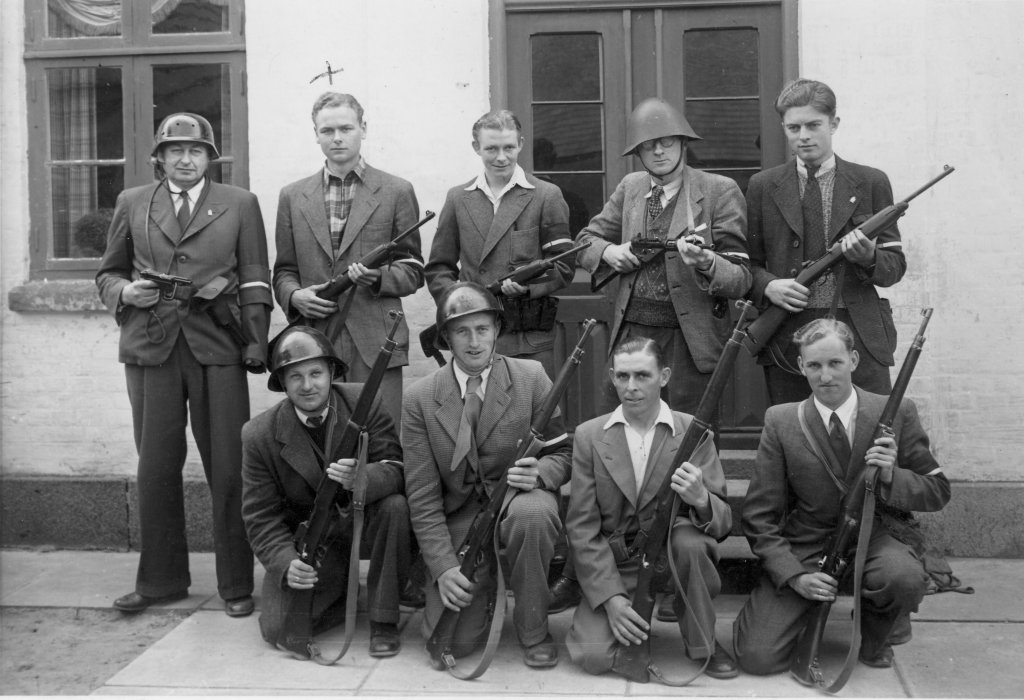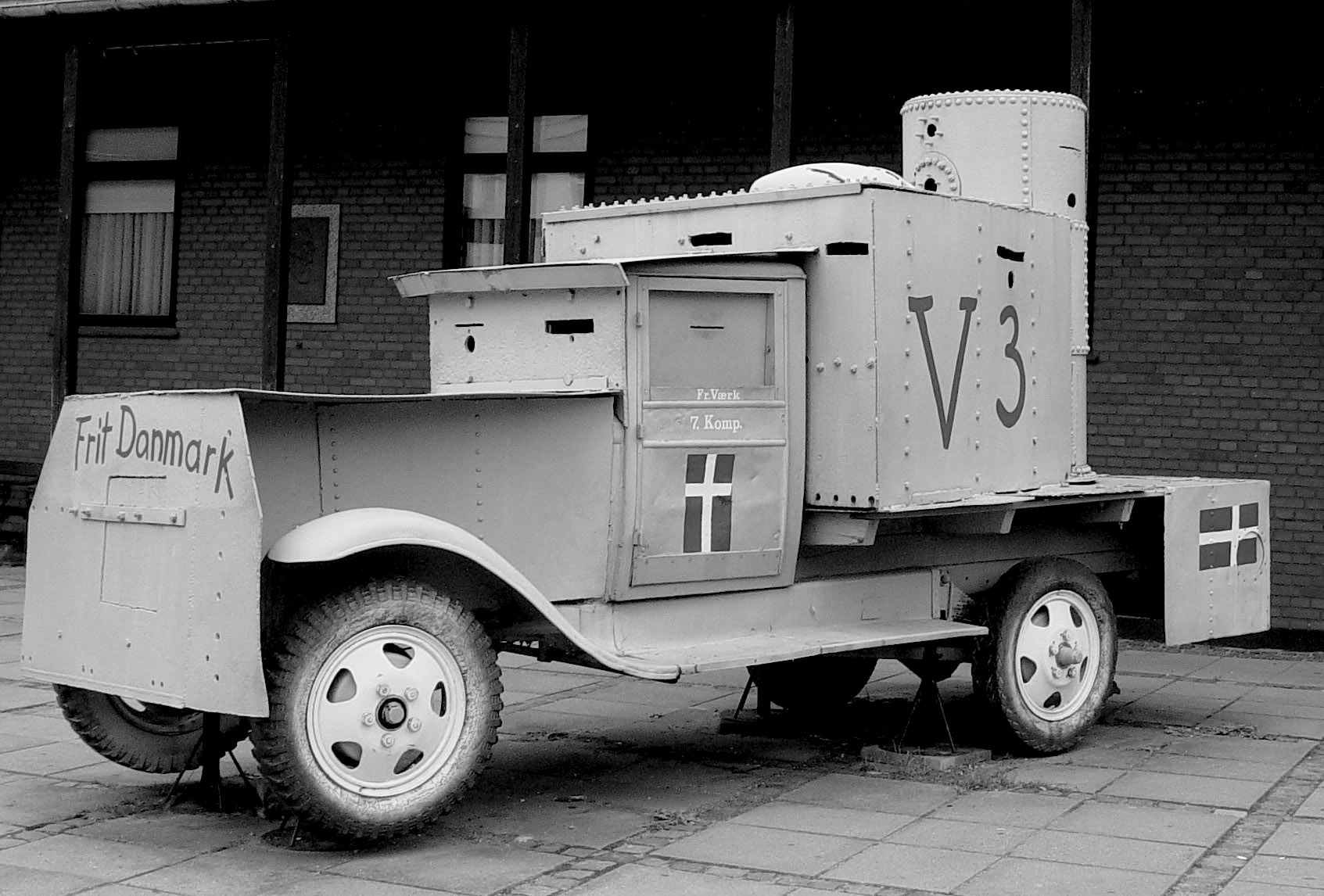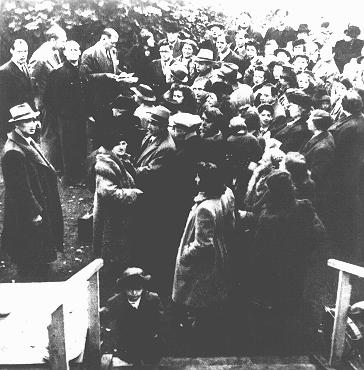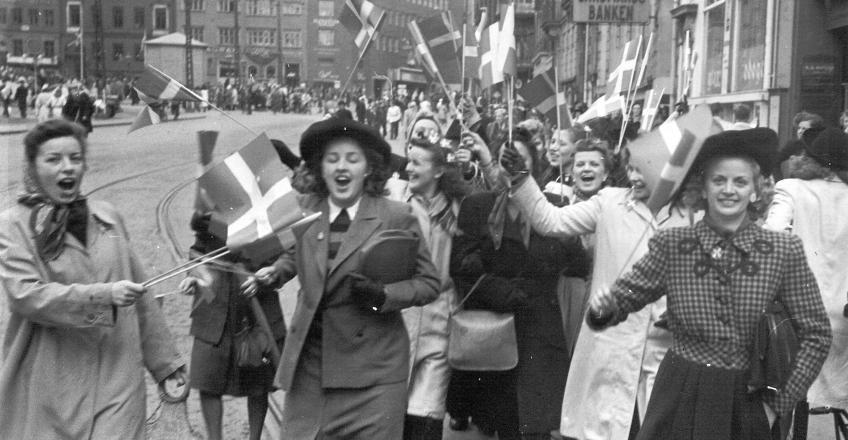“Evil did not triumph in Denmark simply because most Danes would not allow it”1
― Ellen Levine, Darkness Over Denmark
Vision and Motivation
Heavy footsteps echoed ominously around Amalienborg’s deserted palace courtyard. Silently, royal guards raised their rifles to repel the intruders, but alas, it was too late. German bombers droned overhead, their swastikas glinting in the dawn light as pale green leaflets fluttered down on the sleeping city. “OPROP! (Proclamation!),” the leaflets announced in garbled Danish, “[German] military forces have taken over protection of the Danish kingdom’s neutrality…avoid any active or passive resistance…It will be useless and broken with all the instruments of power.”2
Following the preemptive obliteration of Denmark’s air force, German paratroopers descended to secure the nation’s southern cities. As dawn broke, the country’s septuagenarian monarch King Christian X capitulated. “Inwardly shattered,” he stoically announced cooperation with Germany to “spare his country further misfortune.”3 That day, April 9, 1940, the Danes awoke an occupied people, and a “perfect Aryan protectorate” was born, dubbed by Winston Churchill, “Hitler’s pet canary.”4
Only two years earlier, British Prime Minister Neville Chamberlain had announced an agreement with Hitler allowing Germany to annex a large part of Czechoslovakia in return for a promise of peace between Germany and the United Kingdom.5 Yet, shortly after the signing of this agreement, the European continent was once again engulfed by war. This time, however, Germany not only sought territorial expansion, but also the annihilation of the Jewish people. By the time King Christian capitulated, the Nazi plot to annihilate the Jews, the “final solution to the Jewish question,” was complete, and their first concentration camp, Dachau, in which at least 28,000 people would eventually be murdered, already housed thousands of Jews and political prisoners.6 Hopelessly outnumbered by the swelling forces of Hitler’s Third Reich, Denmark’s fate, along with the fate of the country’s Jewish population, seemed inevitable.
Wandering through the streets of the small Danish town of Slagelse the morning after the invasion, 17-year-old schoolboy Arne Sejr came to a sudden halt. Aghast, he stood as smiling crowds applauded a German military band.7 “Show an absolute dignified and correct demeanor. Behave like a good Dane,”8 the country’s well-loved monarch had entreated. “But what was a good Dane,” Arne wondered. By evening he was certain he knew the answer. “Join the struggle for the freedom of Denmark,” he typed, “you shall do a bad job for the Germans” and “you must not shop at Nazi stores.”9 Hastily copying these and other rules, which became known collectively as the “Ten Commandments for Danes,”10 he distributed them to the homes of prominent doctors and lawyers.11 Reminiscing on this period, Arne recalls, “It felt very illegal…ducking through the dark streets where the only sounds were made by the hobnailed boots of German patrols.”12
Arne was not alone. Fuelled by “boundless shame and sadness”13 over Denmark’s humiliating occupation, independent resistance groups “sprouted in a hundred localities and grew like weeds.”14 Together, eight schoolboys formed the Churchill Club, led by 17-year old Knud Petersen. Armed with only matches and gasoline, the group stole weapons, filled gas tanks with sugar and destroyed Nazi munitions.15 Nonchalantly approaching drunk soldiers, younger members of the club feigned interest in the Wehrmacht, while older boys rifled through the soldiers’ jackets and made off with their weapons. “If you older folk will do nothing,” they admonished, “we’ll have to do something instead.”16

Goals and Objectives
Despite their disparate roots and independent actions, Danish resistance groups were united in purpose, with the ultimate goal of regaining freedom, independence and democracy. “Action is required of us all,” insisted politician Christmas Moeller from exile in London, continuing, “It is our duty to have only one thing in view, that which hurts Germany the most… Do your duty. Do your work.”17 Danes, from king to fishwife, heeded this call.
As the first winter of occupation set in, public attitudes towards the Nazi occupiers chilled. Bakeries and streetcars spontaneously emptied as German soldiers entered, with Danes crowding outside even in the biting wind until the Nazis left.18 King Christian responded to his country’s occupiers with frigid, but subtle discourtesy; riding through Copenhagen each morning on horseback the king would warmly greet even the humblest of citizens, while studiously ignoring Nazi salutes.19 On his 72nd birthday, the king received a personal telegram dripping with cloying pleasantries from Hitler himself, to which he replied curtly, “Giving my best thanks, Christian Rex.”20 Incensed by the king’s reception of this “singular honour,” Hitler flew into a rage and an all-out war was narrowly avoided.21
Comedians, students and musicians enthusiastically joined together to form a wave of passive resistance. “Heil!,” yelled a German audience, as a Danish comic flung his arm into a Nazi salute. Pausing slightly he quipped, “this is how high the snow was in Copenhagen last year.”22 Thousands of students gathered to sing rousing patriotic songs outside Amalienborg, the Danish royal family’s winter home, and Beethoven’s Fifth Symphony became a national favorite, as its opening bars were interpreted as a musical Morse code denoting “VVV,” “we will win.”23
In return for King Christian’s quick capitulation, the Nazis had allowed the Danes to retain a degree of autonomy. However, as the occupation wore on, Hitler’s Third Reich gradually tightened its iron grip over the country. In 1941, the Nazis forced the Danish government to outlaw communist activity;24 then, in addition to this, the Nazis commandeered the Danish Navy’s torpedo boats, thereby violating an earlier promise “that the Danish Army and Navy [would] be maintained.”25
As the fictional claim of Denmark’s neutrality slowly evaporated, some resistance groups set their sights on sabotage. However, despite the Nazi’s increased incursion into Denmark’s internal affairs, many Danes balked at the idea of resorting to violence. As resistance groups negotiated this moral quagmire, Hitler’s infamous logistics expert, Adolf Eichmann, grew increasingly irate about the continued survival of Denmark’s 7,500 Jews.26 By the end of 1942, the Nazis had consigned Norway’s Jews to Auschwitz and murdered hundreds of thousands from other European countries, but had not dealt with Denmark’s Jewish population.
Anxious to change this, the Nazis planned a lightning raid for October 1, 1943, Rosh Hashanah (the Jewish New Year), when most Jewish families would be at home. King Christian had always insisted, “there are no Jewish questions in this country…there are only my people,”27 so the Nazis knew that open hostilities against the Jews would have proven politically explosive. Officers ordered that no doors be broken down, but that Jews be removed and quietly extradited. However, when Eichmann’s convoy of trucks closed in on Copenhagen and the Gestapo, the Nazi secret police, rapped aggressively on doors, they found that most Jewish families had already fled.
Tipped off “less than 24 hours”28 in advance by a disillusioned Nazi attaché, resistance groups sprang into action, allowing Jews to slip away “behind a living wall raised by the Danish people.”29 Grabbing a phone book, ambulance driver Jorgen Knudsen thumbed through the pages marking any names that sounded Jewish; he then located as many as he could and drove them to safe houses belonging to complete strangers.30 Doctors admitted perfectly healthy Jews to hospitals, giving them false names and diagnoses and then discharging them secretly as mourners in fake funeral corteges.31 Anxious to raise funds to help Jews flee across the narrow Oresund Straits to Sweden, literature student Elsebet Kieler drove around local manor houses requesting donations. “It was somewhat naive of us to ride around that way,” Elsebet recalls, “…entrusting our little secret to all those we met, but on that occasion our naiveté happened to prove our strength.”32
Holger Danske, a local resistance group, negotiated with fishermen to secure ten boats to make the passage to Sweden. Others followed, and within weeks there were 300 boats sailing 55 illegal escape routes.33 Crammed into the bottom of fishing boats or hidden under piles of straw and herrings, thousands of Jews made the perilous journey through waters laced with sea mines.34 “The smell of fish still reminds me of freedom,”35 recalls Gus Goldberger, who made the journey when he was just nine-years old. In total, 7,000 people, comprising over 90 percent of the Jewish population, successfully made it out of the country, avoiding the Nazis’ terror. “Denmark posed the greatest difficulties,” bemoaned Eichmann, “for most Jews escaped.”36

Not all Danish Jews evaded the Nazis, however. The Nazis unceremoniously flung several hundred Jews, either too frail to flee or unaware of the impending danger, into a German merchant ship and deported them to the infamous Theresienstadt work camp in the present-day Czech Republic.37 Upon learning of this, the Danish government desperately tried to protect its Jewish citizens. The government successfully exploited the Nazis’ own racial policies to secure the release of half-Jewish Danes.38 Refusing to abandon those whose release it could not secure, the government ensured that all imprisoned Danish Jews received Red Cross parcels filled with milk formula and clothes; these clothes were often secretly stashed with vitamins and nutritious food, and are said to have halved the mortality rates of Danish prisoners.39 In an effort to deceive the Danish government, the Nazis even transformed Theresienstadt into a model camp with toy-filled nurseries and manicured gardens when Danish politicians visited.40 Because of the Danish government’s pressure, the vast majority of imprisoned Danish Jews survived. Shortly before the Germans surrendered, in a heated negotiation with Heinrich Himmler, Swedish diplomat Folke Bernadotte succeeded in obtaining the release of thousands of prisoners from Nazi concentration camps, including the 450 remaining Danish Jews in Theresienstadt, whom Bernadotte personally escorted to freedom on April 14, 1945.41
Leadership
Many of Denmark’s famed freedom fighters were neither political elites nor trained revolutionaries; in fact, the majority were ordinary people, students, mothers, fathers and fishermen, who believed that they “had no choice but to help.”42 However, the resistance movement also included several distinct groups, such as the Churchill Club, Holger Danske, and others. Each group had its own leadership structure and tactics, leading to a lack of coordination that proved hazardous from time to time. For example, on one occasion two independent resistance groups planned to sabotage the same factory simultaneously.43 To minimize these incidences, leaders of seven principal resistance groups formed the Freedom Council in early autumn 1943 to “organize and coordinate the activities” of the resistance.44

Civic Environment
With secret messages hidden in loaves of bread,45 coded signals in bookstores46 and midnight sabotage missions,47 accounts of the Danish resistance read like riveting fiction; yet, the consequences for its actors were frighteningly real. Initially anxious to ensure compliance, the Nazis partially granted Denmark territorial integrity and political independence.48 In return, resistance fighters were punished by Danish authorities and generally given jail terms, albeit often minimal.49 When saboteurs decimated a newly converted army barracks and minesweeper just days before their completion,50 Hitler became enraged.51
Successively, Hitler appointed harsher plenipotentiaries to oversee occupied Denmark. He told one of these emissaries, Dr. Werner Best, to “rule with an iron hand.”52 Further, Hitler demanded, “Combat sabotage with terror,”53 and Himmler added, “Prisoners should no longer be turned into decent people, but have their will broken.”54 Following a nationwide strike in August 1943, the German authorities imposed martial law. Strikes were outlawed, curfews enforced and sabotage declared punishable by death.55 The Germans swamped public buildings, the Danish government resigned, and naval officers sank 29 ships while the remainder fled to Sweden.56 Revered resistance leader and poet, Kaj Munk, was assassinated57 and 6,000 Danes, a third of whom were police officers, were sent to concentration camps for their resistance.58
Despite being subjected to torture and starvation, many remained resolute. “I did not need to believe in eternal life,” Jorgen Kieler writes, “With satisfaction [I] thought…the ideals I had fought for would not end with the bullets of the firing squad.”59 Exhausted and emaciated from working tirelessly in German mines, Jorgen continued his resistance by removing key components from equipment.60 Three members of the Churchill Club too continued their efforts during their imprisonment. Sawing off a bar of their cell, they escaped unseen to destroy German property before returning and meticulously replacing the bar.61 “Why don’t you people cry?” one bewildered officer asked, “That’s what they do in every other country.”62
Message and Audience
“Eight-penny worth o’ lies!”63 shouted Danish paper boys selling highly censored broadsheets. Despite the Nazis best efforts, both the mainstream and underground press became the resistance’s “chief weapon.”64 Unaccustomed to restrictions, official newspapers published the mandatory propaganda with sarcastic flair. “Here is the latest communique,” they announced, printing double-spaced articles that encouraged readers to read between the lines.65 “We will win many customers through our low prices,” boasted an advertisement in a conservative newspaper, while a seemingly innocuous article on the architectural design of key landmarks helped British special forces pinpoint their bombing raids to minimize civilian casualties.66
The underground press flourished in wartime Denmark, with over 552 papers publishing an estimated 23 million copies, one even operating brazenly from the basement of Copenhagen’s Nazi headquarters.67 Businessmen painstakingly concealed these publications in pens as they travelled abroad to smuggle critical intelligence to the Allies. “Danes cannot bow to German threats,” Frit Denmark, an illegal paper, enjoined, “even when harsh punishment… awaits us.”68 These papers inspired many Danes to heroically defy their occupier’s will. Coastguards ensured patrol boats were consigned to dry dock,69 shipyard workers slowed their pace of work and explosives experts became inexplicably careless when defusing bombs in critical locations.70
Funds were raised through a roaring trade in banned books, with copies of Hitler’s speeches in suitably derogatory covers and homemade explosive “recipe” books amongst the best sellers. Written in German, one book advised disillusioned soldiers on how to convincingly feign illness, even providing a pre-filled prescription for an incapacitating medication.71 Enraged by the efficacy of the press, Werner Best, Hitler’s emissary to Denmark, warned to no avail, “each editor will be responsible with his head for ensuring that people are no longer poisoned.”72
Lutheran Ministers also used their influence to foster resistance. A bishop’s letter was read to congregations the day after the Jewish roundup, urging them to remember that Jesus himself was born a Jew, and further stating, “we will fight to preserve for our brothers and sisters the same freedom we ourselves value more than life.”73 Ultimately over 90 percent of ministers assisted, with many parishioners freely offering money, accommodation and support to fleeing Jews.74
Outreach Activities
 The Danish resistance could not have succeeded in thwarting the Nazis’ plan without the cooperative participation of disparate parts of Danish society. Despite the existence of radical political and class divides, resistance members were able to unite and remain steadfast in their fight against Nazism. Brave actions, like Arne Sejr’s publishing of the “Ten Commandments for Danes,” led to a realization among the population that their grievances against the Nazis were widely shared, even by those with whom they may have differed on a range of other issues. As a result, Danes from many parts of society, young and old, friends and strangers, policemen, clergymen, sailors, fishwives, and even king, all participated in the resistance. Their ability to unite hinged upon their shared beliefs. “We had to admit we meant very different things by the word democracy,” recalls Jorgen Kieler, a member of Holger Danske, “But… the persecution of the Jews made us recognise one joint ideological attitude – our fervent embrace of rights.”75
The Danish resistance could not have succeeded in thwarting the Nazis’ plan without the cooperative participation of disparate parts of Danish society. Despite the existence of radical political and class divides, resistance members were able to unite and remain steadfast in their fight against Nazism. Brave actions, like Arne Sejr’s publishing of the “Ten Commandments for Danes,” led to a realization among the population that their grievances against the Nazis were widely shared, even by those with whom they may have differed on a range of other issues. As a result, Danes from many parts of society, young and old, friends and strangers, policemen, clergymen, sailors, fishwives, and even king, all participated in the resistance. Their ability to unite hinged upon their shared beliefs. “We had to admit we meant very different things by the word democracy,” recalls Jorgen Kieler, a member of Holger Danske, “But… the persecution of the Jews made us recognise one joint ideological attitude – our fervent embrace of rights.”75
On April 30, 1945, realizing defeat was imminent, Hitler raised a gun to his temple and committed suicide. Four months later, Japan surrendered, and the Second World War officially came to an end. By then over six million Jewish men, women and children had been murdered by the Nazi regime, yet, due to the tireless efforts of the Danish resistance, less than one percent of Denmark’s Jewish population was numbered amongst them. “There were so many wonderful people who saved our lives by endangering their own” recalls one survivor gratefully.76 As the Third Reich collapsed, many exiled Jews returned to Denmark to find their homes and possessions safely guarded by neighbors who welcomed them back “emotionally with open arms and hearts.”77
Today, towering above Jerusalem’s pine forest stands Yad Vashem, a permanent memorial to the victims of the Holocaust. There, at Yad Vashem, a tree stands in the Avenue of the Righteous in honor of the Danish underground. As a special gesture, because “Danes of all ages, classes and backgrounds participated in the rescue effort,” Yad Vashem bestowed the title “Righteous Among the Nations” on the Danish people.78 Their actions and bravery demonstrated that an “unarmed, orderly people” can “win against an army just by saying no.”79
Learn More
Levine, E. (2000). Darkness over Denmark: The Danish Resistance and the Rescue of the Jews (available free on www.openlibrary.org)
Sutherland, C. (1991). Monica: Heroine of the Resistance (available free on www.openlibrary.org)
Ackerman, P., & DuVall, J. (2000). A Force More Powerful: A Century of Non-Violent Conflict
Kieler, J. (2008). Resistance Fighter
Werner, E. (2004). A Conspiracy of Decency: The Rescue of the Danish Jews in World War II
Footnotes
- Levine, E. (2000). Darkness over Denmark: The Danish Resistance and the Rescue of the Jews. Holiday House. p. vii
- Ibid., 9
- Ackerman, P., & DuVall, J. (2000). A Force More Powerful: A Century of Non-Violent Conflict. Palgrave Macmillan Trade. p.210
- Levine, E. p. vi
- Kieler, J. (2008). Resistance Fighter. Gefen Publishing House. p.17
- “Holocaust Encyclopedia,” United States Holocaust Museum. Retrieved December 5, 2014, from http://www.ushmm.org/wlc/en/article.php?ModuleId=10005214.
- Ackerman, P., & DuVall, J. p.212
- Sutherland, C. (1991). Monica: Heroine of the Resistance. Canongate Press. p.103
- Ackerman, P., & DuVall, J. p.213
- Ibid., 212
- “Danish citizens resist the Nazis, 1940-1945,” Global Nonviolent Action Database. Retrieved December 9, 2014, from http://nvdatabase.swarthmore.edu/content/danish-citizens-resist-nazis-1940-1945.
- Werner, E. (2004). A Conspiracy of Decency: The Rescue of the Danish Jews in World War II. Basic Books. p.11
- Kieler, J. p.20
- Ackerman, P., & DuVall, J. p.225
- Kieler, J. p.139
- Ackerman, P., & DuVall, J. p.215
- Ibid., 217
- Werner, E. p.11
- Levine, E. p.10
- Sutherland, C. p.139
- Ibid.
- Ibid.
- Werner, E. pp.17-18
- Kieler, J. p.31
- Leistikow, Gunnar, “Denmark Under the Nazi Heel,” Foreign Affairs. Volume 21, Number 2. Council on Foreign Relations: January, 1943. Retrieved December 11, 2014, from http://www.foreignaffairs.com/articles/70240/gunnar-leistikow/denmark-under-the-nazi-heel.
- “Holocaust Encyclopedia: Denmark,” United States Holocaust Museum. Retrieved December 5, 2014, from http://www.ushmm.org/wlc/en/article.php?ModuleId=10005209.
- Sutherland, C. p.150
- Levine, E. p.68
- Ackerman, P., & DuVall, J. p.228
- Ibid.
- Werner, E. p.49
- Kieler, J. p.98
- Ibid. p.96
- Werner, E. p.80
- Ibid. p.69
- Levine, E. p.66
- Sutherland, C. p.150
- Werner, E. p.110
- Ibid., 108
- Ibid., 122
- Ibid., 120
- Ibid., 80
- Kieler, J. p.128
- Ibid., 80
- Ibid., 228
- Levine, E. p.84
- Sutherland, C. p.126
- Ackerman, P., & DuVall, J. p.210
- Werner, E. p.20
- Ibid., 22
- Sutherland, C. p.129
- Ackerman, P., & DuVall, J. p.218
- Kieler, J. p.242
- Ibid.
- Werner, E. p.23
- Levine, E. p.57
- Ackerman, P., & DuVall, J. p.224
- Werner, E. p.4
- Kieler, J. p.236
- Ibid., 290
- Sutherland, C. p.126
- Kieler, J. p.227
- Denmark: Shadow of the Swastika. (1941, July). TIME
- Kieler, J. p.36
- Ackerman, P., & DuVall, J. p.213
- Werner, E. p.18
- Ibid., 19
- Ackerman, P., & DuVall, J. p.223
- Werner, E. p.38
- Sutherland, C. p.134
- Werner, E. p.19
- Levine, E. p.64
- Kramer, N. (2007). Civil Courage: A Response to Contemporary Conflict and Prejudice. Peter Lang Publishing Inc., pp.359-360
- Levine, E. p.vii
- Kieler, J. p.91
- Werner, E. p.47
- Ibid., 154
- Ibid., 168
- Ibid., 131



